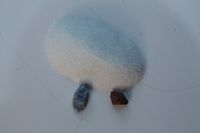Alumina
Alumina is the chemical , or aluminium(III) oxide. It occurs naturally as hexagonal crystals called corundum, the second hardest mineral on Earth.[1] Used without qualification, aluminium oxide usually refers to alumina rather than the other oxides of aluminium. Aluminium is the third most common element on Mars after Oxygen and silicon.
Most aluminium on Mars is not in the form of alumina but rather in the form of alumina-silicates, such as Feldspar. Aluminium is also a component of volcanic rocks such as basalt.

Characteristics
The hardness of corundum by definition 9 on Mohs' scale and it has a white streak and vitreous lustre.[1]. Corundum has a specific gravity between 3.96[2] and 4.1[1]. The different varieties have refractive indices varying from between 1.759 and 1.767 to between 1.770 and 1.779.[2]
Some corundum, including all rubies, display asterism, which is to say that they reflect light in such a way as to form a six-sided star.[1][2]
Variants
The colour of a corundum crystal depends on impurities.
- Red corundum is known as ruby. The red color of Ruby comes from an impurity of considerably less than 1% Chromic oxide. The chromium is what permits the ruby to be used for a laser, producing red light. [3]
- Blue corundum is known as sapphire. It gets its colour from iron and titanium impurities[1]
- Colourless (pure) corundum is known as white sapphire.
- Other varieties of corundum crystal are known by colour sapphire. These are pink, yellow, violet and green sapphire[1].
Occurrence
On Earth, corundum mainly occurs in metamorphic rock, as well as in alluvial deposits.[1]
Alumina is commonly found in clays that were created on Mars as a result of gravity and chemical separation in the primordial oceans.
In situ Production
Alumina may be extracted from clays or from minerals such as Feldspar.
For production from clays, Hydrochloric acid processes might be used to separate the alumina from the other elements in the clays. Aluminium trichloride in solution would be precipitated as alumina hexahydrate, then calcinated into alumina (The Orbite process).
Use
- It is used as an abrasive.[1]
- Used in the production of refractory.[1]
- Alumina in clay is an important component of ceramics., bricks and other building materials.
- Ruby lasers are based around synthetic ruby crystals, portions of which are doped with chromium.
- Alumina is the main component of aluminium ore.
- Both natural and synthetic corundum is used in jewelry.
- As a catalyst in the Sabatier process.
References
- ↑ 1.0 1.1 1.2 1.3 1.4 1.5 1.6 1.7 1.8 B. Cairncross - Field guide to rocks and minerals of Southern Africa 2004. ISBN 978-1-86872-985-2 pp. 80-82
- ↑ 2.0 2.1 2.2 R. Webster & E.A. Jobbins - Gemmologists' compendium 7th ed. 2001. ISBN 978-0-7198-0291-1 p. 36.
- ↑ McGRAW-HILL ENCYCLOPEDIA OF Science & Technology 8th Edition (c) 1997, vol 15, page 688.







